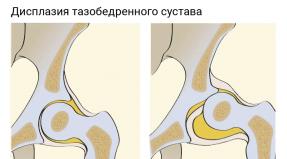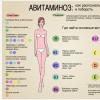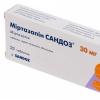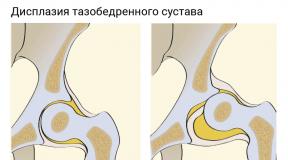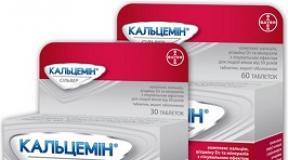Calcemin instructions for use, contraindications, side effects, reviews. What is better to take - Calcium D3 Nycomed, Calcemin or Calcemin Advance Calcemin for children instructions for use
Active substances: calcium (calcium citrate tetrahydrate and calcium carbonate) 250 mg; vitamin D3 (cholecalciferol) 50 IU; zinc (zinc oxide) 2 mg; copper (copper oxide) 0.5 mg; manganese (manganese sulfate) 0.5 mg; boron (sodium borate decahydrate) 50 mcg;
Excipients: soy polysaccharide - 10 mg; sodium lauryl sulfate - 5 mg; colloidal silicon dioxide - 3.9 mg; croscarmellose sodium 28 mg; MCC - 199.45 mg; stearic acid - 35 mg; magnesium stearate - 10 mg;
Film sheath: hypromellose - 11.71 mg; triacetin - 2.53 mg; mineral oil - 1.27 mg; sodium lauryl sulfate - 0.004 mg; titanium dioxide - 7.03 mg; magnesium silicate - 5 mg
Indications for use Calcemin
Prevention and complex treatment of osteoporosis of various origins; replenishment of calcium and microelement deficiency in adolescents, women during pregnancy and breastfeeding.
Contraindications to the use of Calcemin
- increased individual sensitivity to any of the components of the drug;
- hypercalcemia and hypercalciuria;
- nephrolithiasis;
- hypervitaminosis D3;
- severe renal failure;
- active form of tuberculosis;
- decalcifying tumors (myeloma, bone metastases, sarcoidosis);
- children's age up to 5 years.
Carefully: benign granulomatosis; taking cardiac glycosides and thiazide diuretics; pregnancy; lactation period.
Children from 5 to 12 years old - 1 tablet 1 time per day with meals.
Adults and children over 12 years old - 1 tablet 2 times a day with meals.
During pregnancy and breastfeeding: from the 20th week of pregnancy and the entire period of breastfeeding - 1 table. 2 times a day.
The minimum course of taking the drug for the treatment of osteoporosis as part of complex therapy for adults is 3 months, a longer course - after consultation with a doctor.
The minimum course of taking the drug for the prevention of osteoporosis for adults is 1 month, a longer course - after consulting a doctor.
The minimum course of taking the drug for children and adults with a deficiency of calcium and trace elements is 2-3 months, a longer course - after consulting a doctor.
A second course of taking the drug is possible 1 month after the end of treatment.
The use of Calcemin during pregnancy and lactation
During pregnancy and breastfeeding, the drug should be taken in consultation with the doctor. The daily dose should not exceed 1500 mg of calcium and 600 IU of vitamin D3, hypercalcemia that develops against an overdose during pregnancy can cause mental and physical developmental defects in the fetus. In lactating women, it should be borne in mind that cholecalciferol and its metabolites penetrate into breast milk, so it is necessary to control the intake of calcium and vitamin D3.
pharmachologic effect
Replenishing calcium deficiency, regulating calcium-phosphorus metabolism, replenishing the deficiency of macro- and microelements, replenishing vitamin D deficiency.
Pharmacodynamics
Combined preparation containing calcium, vitamin D3, osteotropic minerals that regulate calcium metabolism.
The pharmacological action of the drug is determined by the properties of its constituent ingredients.
Calcium is involved in the formation of bone tissue, reduces resorption (resorption) and increases bone density, prevents diseases of the musculoskeletal system, strengthens the skeletal system and joints.
Calcium citrate ensures the absorption of calcium, regardless of the functional state of the gastrointestinal tract, which is applicable for the treatment of patients with reduced secretory function of the gastrointestinal tract, as well as against the background of treatment with drugs to reduce secretion; reduces the level of markers of bone tissue resorption, which indicates a slowdown in the processes of bone tissue destruction; regulates the level of parathyroid hormone, which leads to improved regulation of calcium homeostasis; does not increase the content of oxalates and calcium in the urine, therefore, does not cause the risk of kidney stones; does not block the absorption of iron, which reduces the risk of developing iron deficiency anemia.
Colecalciferol (vitamin D3) regulates the metabolism of calcium and phosphorus in the body, participates in the formation of the bone skeleton, helps maintain bone structure, enhances calcium absorption in the intestine and phosphorus reabsorption in the renal tubules.
Zinc promotes the synthesis of sex hormones, which prevents the destruction of bone tissue.
Manganese is involved in the formation of proteoglycans, which improves the quality of bone tissue and forms the protein matrix of bone tissue.
Copper is involved in the synthesis of collagen and elastin, which is part of the bone and connective tissue, which affects the formation of bone mass.
Boron reduces excess parathyroid hormone activity, improves calcium absorption, reduces the risk of developing cholecalciferol deficiency, and helps prevent osteoporosis.
Side effects of Calcemin
Nausea, vomiting, flatulence, diarrhea, constipation, hypercalcemia and hypercalciuria, allergic reactions (itching, rash, urticaria).
special instructions
The dose should not exceed that specified in the instructions, because. increased calcium intake can inhibit intestinal absorption of iron, zinc, and other essential minerals.
Overdose
Symptoms: decreased appetite, thirst, polyuria, dizziness, fainting, constipation, nausea and vomiting. With prolonged use of excess doses - calcification of blood vessels and tissues.
Treatment: it is necessary to reduce the dose or stop using the drug. You should induce vomiting, wash the stomach. Therapy is symptomatic.
drug interaction
With the simultaneous use of the drug Calcemin® with vitamin A, the toxicity of vitamin D3 decreases.
Phenytoin, barbiturates, corticosteroids reduce the effectiveness of vitamin D3.
Laxatives reduce the absorption of vitamin D3.
GCS, hormonal contraceptives for systemic use, levothyroxine impair the absorption of calcium ions.
With the simultaneous use of tetracyclines, the interval between doses should be at least 3 hours, bisphosphonates and sodium fluoride (their absorption is impaired) - at least 2 hours.
With the combined use of the drug Calcemin® with cardiac glycosides, their toxicity increases (ECG and clinical condition monitoring is necessary), with thiazide diuretics - the risk of developing hypercalcemia increases, with furosemide and other loop diuretics - calcium excretion by the kidneys increases.
Calcemin® should not be used in conjunction with BPC.
Calcium D3 Nycomed and Calcemin are medicines based on cholecalciferol (vitamin D3) and calcium. The drugs are included in the pharmacological group of drugs that control phosphorus-calcium metabolism in the human body.
This complex is used both for the treatment and for the prevention of the following diseases:
- deficiency of calcium and vitamin D3;
- osteoporosis.
Contraindications
The main contraindications to the use of the drug are:
- tuberculosis occurring in an open form;
- sarcoidosis;
- serious pathological processes in the kidneys;
- nephrolithiasis (kidney stone disease);
- individual immunity of the drug components;
- increased amount of calcium in the urine and blood;
- hypervitaminosis of vitamin D3;
- up to three years of age.
The drug is intended for oral use. The tablet can either be chewed or sucked after a meal. If the drug is used as a prevention and treatment of calcium and vitamin D3 deficiency, then the recommended doses will be as follows:
- for adults - 1 tablet from one to three times a day;
- for children after 5 years of age - 1 tablet up to two times during the day;
- for babies 3 - 5 years old, the dosage is prescribed by the attending doctor.
If osteoporosis is being prevented, then adults are prescribed one pill twice a day. For the treatment of this disease, the dosage will be different - one tablet three times a day.
Side effects
Undesirable manifestations that may develop while taking the drug Calcium D3 Nycomed include the following:
- disorders of the gastrointestinal tract;
- allergic reaction;
- hypercalcemia or hypercalciuria.
Use during pregnancy
The drug Calcium D3 Nycomed is allowed to be used during pregnancy, but it is necessary to strictly adhere to the dosage prescribed by the doctor and the duration of the course of therapy. In order to choose the right course of treatment for the expectant mother, the specialist will prescribe tests without fail. This is necessary to determine the amount of calcium in the body. If this trace element is supplied more than the norm, this can significantly strengthen the bones of the unborn baby, which will cause complications during the process of labor.
Calcemin
Direct indications for the use of the Calcemin vitamin complex are:
- osteoporosis;
- insufficient intake of calcium in the body in adulthood and adolescence, during pregnancy and breastfeeding.
Contraindications
- individual intolerance to any component of the drug;
- urolithiasis disease;
- as well as patients who have not reached the age of 5.
Dosage and method of application
Calcemin is intended for oral administration. As a treatment for adult patients, including expectant and nursing mothers, as well as for children from 12 years of age, the standard dose is 1 tablet 2 times a day. For children 5 - 12 years old - 1 tablet throughout the day.
As a preventive measure - 1 tablet per day. The duration of therapy is determined by the doctor and depends on the patient's condition and the nature of the course of the disease.
Side effects
Reception of Calcemin can provoke the following reactions of the body:
- violations in the work of the digestive tract;
- manifestations of allergies;
- hypercalciuria or hypercalcemia.
Application during pregnancy
Calcemin during pregnancy and during breastfeeding is recommended to take 1 tablet twice a day before meals or during meals. The drug must be prescribed by the doctor after the tests.
Calcemin Advance
- to prevent osteoporosis, as well as in the complex therapy of this disease;
- for women who are in a period of natural menopause or caused by surgery;
- for patients taking corticosteroids and immunosuppressants for a long time;
- as a therapy for diseases of the musculoskeletal system;
- to eliminate calcium deficiency in adolescence.
Contraindications
A direct ban on the use of the drug Calcemin Advance are:
- individual immunity of the components of the drug;
- urolithiasis disease;
- hypercalciuria, hypercalcemia;
- the age of the patient is up to 12 years.
Method of application and dosage
The drug is taken with food. For treatment, adults and children over 12 years of age are recommended to take 1 tablet 2 times a day. As a preventive measure - 1 tablet per day.
Side effects
While taking the drug, you may experience:
- nausea, vomiting, flatulence;
- hypercalcemia and hypercalciuria;
- allergy manifestations.
Use during pregnancy and lactation
During pregnancy and breastfeeding, women must necessarily coordinate the intake of the drug with the attending doctor.
You should know that the daily dose of calcium should not be more than 1500 mg, and vitamin D3 - no more than 600 IU. If more than the maximum dose enters the body of a pregnant woman, then hypercalcemia develops. And this can provoke defects in mental and physical development in the unborn child. It should also be borne in mind that in lactating women, calcium and vitamin D3 penetrate into breast milk.
Comparative characteristics of drugs
Let's get acquainted with the distinctive features of preparations containing calcium and vitamin D3.
| Calcemin | Calcemin Advance | Calcium D3 Nycomed | |
| Compound | Calcium - 250 mg in its pure form) + vitamin D (50 IU), as well as zinc -2 mg, copper - 500 mcg, boron - 50 mcg, manganese - 500 mcg. | Calcium - 500 mg in pure form + vitamin D (200 IU), zinc - 7.5 mg, copper - 1 mg, boron - 250 mcg, manganese - 1.8 mg, magnesium - 40 mg. | Calcium - 1250 mg + Colecalciferol - one tablet contains 500 mg of pure calcium + 200 IU of vitamin D. |
| Release form | Coated tablets | Coated tablets | Chewable tablets with orange or mint flavor. |
| Amount in a package | In a jar - tablets of 30, 60, 100, 120 pieces. | In a jar - tablets of 30, 60, 120 pieces. | Chewable pill bottles of 20, 30, 50, 100 pieces. |
| Country of origin / price | Russia / the cost of the drug (30 tablets) - 195 - 214 rubles. | Russia / price (30 tablets) - from 140 to 170 rubles | Norway / package price (30 tablets) - from 150 to 190 rubles |
| Use during pregnancy | It is prescribed only by a specialist at a gestational age from 21 to 40 weeks. | It is allowed for pregnant women after the 20th week of pregnancy, if there are strict indications. The dosage and duration of therapy is prescribed by the attending physician. | It can be taken throughout the entire period of pregnancy, however, strict adherence to the dosage is necessary, which is prescribed only by a doctor. |
What is the best drug?
In order to determine which drug should be taken: Calcium D3 Nycomed or Calcemin, as well as what is better during pregnancy, you need to compare the drugs with each other.
The main difference between the drug Calcemin and Calcium D3 Nycomed is the presence in the first preparation of a complex of minerals - zinc, copper, manganese and boron. If we talk about the quantitative indicator of calcium, then in the drug Calcium D3 Nycomed it contains 5 times more.
All of these drugs are good sources for replenishing the body with calcium. These drugs are used both for the treatment of osteoporosis and for preventive purposes. However, it should be noted that there are more contraindications to the use of Calcium D3 Nycomed. And this reduces the number of patients who can take this medication.
Calcemin is a regulator of phosphorus-calcium metabolism from the German pharmaceutical company Bayer AG. Preparations based on this mineral have been used in medicine since the time of Hippocrates. This macronutrient supports a number of important functions of the body: structural, neuromuscular, enzymatic, signaling. The problem of combating osteoporosis is no less “age-related”. This systemic bone disease, characterized by a decrease in their mineral density (BMD) and damage to tissue structures at the micro level, leads to an increase in bone fragility and an increase in the risk of fractures. According to statistics, more than 30% of women aged 65 years and older have had a fracture. According to experts, the prevention of this disease with calcium preparations is advisable even for women whose BMD indicators are normal. Against the background of the use of drug therapy, the risk of bone fractures is reduced by 10% or more, and in patients with vitamin D deficiency - by 30%. Calcemin is a third generation drug, one tablet of which contains 250 mg of elemental calcium (as calcium citrate and calcium carbonate), as well as vitamin D, zinc, manganese, copper and boron. Due to such a significant concentration of calcium, the drug can be taken at any time, without being attached to meals. Calcium citrate provides high bioavailability of the drug in diseases of the gastrointestinal tract that impair absorption, and also significantly reduces the risk of urolithiasis with prolonged pharmacotherapy.
Even if Calcemin alone is used, this will be enough to reduce pain in the spine and normalize bone mineral density in patients with postmenopausal osteoporosis. The drug is well tolerated and practically does not cause any undesirable side reactions. The microelements included in its composition have the most positive effect on cartilage tissue, which makes it possible to use Calcemin in osteochondrosis, osteoarthrosis, traumatic injuries of individual parts of the musculoskeletal system, as well as to normalize phosphorus-calcium metabolism in the elderly (mainly in women in menopausal period). The drug is also in demand during pregnancy, as an aid in the treatment of periodontal diseases, in childhood and adolescence during active growth. When using Calcemin, one should not go beyond the doses specified by the manufacturer, because. otherwise, excess calcium may inhibit absorption in the digestive tract of other essential macro- and micronutrients. The drug is taken one tablet twice a day (persons under 12 years old - 1 time per day). The optimal time of admission is before meals or during meals, although this, as noted above, is not of fundamental importance. It is best to take the tablet with water or juice. Duration of admission - up to 1 month with the possibility of extending the course in agreement with the doctor.
Pharmacology
Combined preparation containing calcium, vitamin D 3 , osteotropic minerals that regulate calcium metabolism. The pharmacological action of the drug is determined by the properties of its constituent components.
Calcium is involved in the formation of bone tissue, reduces resorption and increases bone density, prevents diseases of the musculoskeletal system, strengthens bone tissue and joints. Calcium citrate ensures the absorption of calcium, regardless of the functional state of the gastrointestinal tract, which is applicable for the treatment of patients with reduced secretory function of the gastrointestinal tract, as well as against the background of treatment with drugs to reduce secretion; reduces the level of markers of bone tissue resorption, which indicates a slowdown in the processes of bone tissue destruction; regulates the content of parathyroid hormone, which leads to improved regulation of calcium homeostasis; does not increase the content of oxalates and calcium in the urine, therefore does not cause the formation of kidney stones; does not block the absorption of iron, which reduces the risk of developing iron deficiency anemia.
Colecalciferol (vitamin D 3) regulates the metabolism of calcium and phosphorus in the body, participates in the formation of the bone skeleton, helps maintain bone structure, enhances calcium absorption in the intestine and phosphorus reabsorption in the renal tubules.
Zinc promotes the synthesis of sex hormones, which prevents the destruction of bone tissue.
Manganese is involved in the formation of proteoglycans, which improves the quality of bone tissue and forms the protein matrix of bone tissue.
Copper is involved in the synthesis of collagen and elastin, which is part of the bone and connective tissue, which affects the formation of bone mass.
Boron reduces excess parathyroid hormone activity, improves calcium absorption, reduces the risk of developing cholecalciferol deficiency, and helps prevent osteoporosis.
Pharmacokinetics
Data on the pharmacokinetics of the drug Calcemin ® are not provided.Release form
Tablets, film-coated, white, oval, biconvex, scored on one side.
Excipients: soy polysaccharide - 10 mg, sodium lauryl sulfate - 5 mg, colloidal silicon dioxide - 3.9 mg, croscarmellose sodium - 28 mg, microcrystalline cellulose - 199.45 mg, stearic acid - 35 mg, magnesium stearate - 10 mg.
Shell composition: hypromellose - 11.71 mg, triacetin - 2.53 mg, mineral oil - 1.27 mg, sodium lauryl sulfate - 4 µg, titanium dioxide - 7.03 mg, magnesium silicate - 5 mg.
30 pcs. - high-density polyethylene bottles (1) - cardboard packs.
60 pcs. - high-density polyethylene bottles (1) - cardboard packs.
120 pcs. - high-density polyethylene bottles (1) - cardboard packs.
Dosage
The drug is taken orally.
Adults and children over 12 years of age are prescribed 1 tab. 2 times / day during meals.
Children aged 5 to 12 years are prescribed 1 tab. 1 time / day during a meal.
From the 20th week of pregnancy and during the entire period of breastfeeding, 1 tab. 2 times/day
The minimum duration of use of the drug for the treatment of osteoporosis as part of complex therapy in adults is 3 months, in order to prevent osteoporosis in adults - 1 month, with calcium and microelement deficiency in children and adults - 2-3 months. An increase in the duration of the drug is possible only after consulting a doctor.
A second course of taking the drug is possible 1 month after the end of treatment.
Overdose
In case of an overdose of the drug, the development of hypervitaminosis D, hypercalcemia and hypercalciuria is possible.
Symptoms: loss of appetite, thirst, polyuria, dizziness, fainting, constipation, nausea and vomiting. With prolonged use in high doses - calcification of blood vessels and tissues.
Treatment: it is necessary to reduce the dose or stop using the drug. In case of accidental overdose, induce vomiting, gastric lavage. Symptomatic therapy is indicated.
Interaction
With the simultaneous use of the drug Calcemin ® with vitamin A, the toxicity of vitamin D 3 decreases.
Phenytoin, barbiturates, glucocorticoids reduce the effectiveness of vitamin D 3 .
Laxatives reduce the absorption of vitamin D 3 .
Glucocorticoids, hormonal contraceptives for systemic use, levothyroxine impair the absorption of calcium ions.
With simultaneous use with tetracycline, the interval between doses should be at least 3 hours, with bisphosphonates and sodium fluoride - at least 2 hours (their absorption is impaired).
With the combined use of the drug Calcemin ® with cardiac glycosides, the toxicity of the latter increases (ECG and clinical condition monitoring is necessary).
With simultaneous use with thiazide diuretics, the risk of developing hypercalcemia increases, with furosemide and other "loop" diuretics, calcium excretion by the kidneys increases.
Do not use Calcemin ® simultaneously with calcium channel blockers.
Side effects
From the digestive system: nausea, vomiting, flatulence, diarrhea, constipation.
From the side of metabolism: hypercalcemia and hypercalciuria.
Allergic reactions: itching, rash, urticaria.
With caution, the drug should be prescribed for benign granulomatosis, the simultaneous use of cardiac glycosides and thiazide diuretics, pregnancy, and lactation.
Application features
Use during pregnancy and lactation
During pregnancy and lactation, the use of the drug should be agreed with the doctor.
The daily dose should not exceed 1500 mg of calcium and 600 IU of vitamin D 3 . Hypercalcemia, which develops against the background of an overdose during pregnancy, can cause defects in the mental and physical development of the fetus.
In lactating women, it should be taken into account that cholecalciferol and its metabolites are excreted in breast milk, so it is necessary to take into account the intake of calcium and vitamin D 3 from other sources.
Application for violations of kidney function
The use of the drug is contraindicated in severe renal failure, urolithiasis.
Use in children
The use of the drug in children under the age of 5 years is contraindicated.
special instructions
When using the drug, do not exceed the recommended doses, because. increased calcium intake can inhibit intestinal absorption of iron, zinc, and other essential minerals.
Influence on the ability to drive vehicles and control mechanisms
Calcemin is a combination drug that regulates phosphorus-calcium metabolism, compensates for the lack of micro- and macroelements and vitamin D deficiency, as well as prevents diseases of the musculoskeletal system and strengthens joints and bones.
In this article, we will look at why doctors prescribe Calcemin, including instructions for use, analogues and prices for this drug in pharmacies. Real REVIEWS of people who have already used Calcemin can be read in the comments.
Composition and form of release
Calcemin is produced in the form of film-coated tablets: white, biconvex, oval, with a risk on one side (30, 60 or 120 pieces in high-density polyethylene bottles, 1 bottle in a cardboard box).
The composition of 1 tablet includes active substances:
- Calcium (500.0 mg per 1 tablet) - strengthens bones and blood vessels, is necessary for muscle contraction, blood clotting, and the full functioning of the nervous system.
- Magnesium (40.0 mg) - contributes to the restoration of bone tissue, calms the nervous system, participates in protein synthesis, blood clotting, regulation of the heart (included in many preparations for the heart, such as "Doppelgerz active" or "Magnesium B6").
- Vitamin D3 (200 international units per 1 tablet) - strengthens bones, promotes their regeneration. The body is only able to absorb calcium in the presence of vitamin D.
- Manganese (1.9 mg) - participates in the construction of bone and cartilage tissue, promotes the absorption of calcium.
- Zinc (7.4 mg) - accelerates the regeneration of all types of tissues, activates the activity of enzymes.
- Boron (250 mcg) - regulates the activity of parathyroid hormone, which, in turn, affects metabolism.
- Copper (1.0 mg) - provides strength to all types of connective tissue.
Clinico-pharmacological group: a drug that affects the phosphorus-calcium metabolism.
Indications for use Calcemin
The drug Calcemin is prescribed in such cases:
- Prevention and complex treatment of osteoporosis of various origins.
- In conditions of deficiency of calcium and vitamin D3 in the body associated with malnutrition, or when the intake of calcium and cholecalciferol from food is not enough.
In addition, it can be prescribed with an increased need for calcium and vitamin D3 during pregnancy and during breastfeeding, as well as in children over 6 years of age during a period of intensive growth.

pharmachologic effect
Combined drug. Regulates phosphorus-calcium metabolism. Compensates for the deficiency of trace elements, calcium and vitamin D3, helps strengthen bones and joints, and prevents diseases of the musculoskeletal system.
Instructions for use
According to the instructions for use, Calcemin is taken orally, during a meal. As a rule, the drug is prescribed as follows:
- Adults and children over 12 years of age are prescribed 1 tab. 2 times / day during meals.
- Children aged 5 to 12 years are prescribed 1 tab. 1 time / day during a meal.
- From the 20th week of pregnancy and during the entire period of breastfeeding, 1 tab. 2 times/day
The minimum duration of use of the drug for the treatment of osteoporosis as part of complex therapy in adults is 3 months, in order to prevent osteoporosis in adults - 1 month, with a deficiency of calcium and trace elements in children and adults - 2-3 months. An increase in the duration of the drug is possible only after consulting a doctor.
A second course of taking the drug is possible 1 month after the end of treatment.
Contraindications
The use of Calcemin is contraindicated in case of hypersensitivity to the components that make up the drug, as well as in the presence of hypercalciuria, hypercalcemia and urolithiasis.
Do not use the product in children under 5 years of age.
Side effects
During the use of Calcemin, in some cases, side effects are possible, namely: the occurrence of pain in the abdominal region and dyspeptic symptoms (constipation, diarrhea, nausea, vomiting). In addition, with prolonged use of the drug, there is a risk of developing hypercalcemia and hypervitaminosis D.
The possibility of developing mild to moderate allergic reactions in the patient is not excluded: rash, urticaria, itching. In very rare cases, there is a possibility of a severe hypersensitivity reaction (anaphylactic shock).

Pregnancy and lactation
During pregnancy and lactation, the use of the drug should be agreed with the doctor.
The daily dose should not exceed 1500 mg of calcium and 600 IU of vitamin D3. Hypercalcemia, which develops against the background of an overdose during pregnancy, can cause defects in the mental and physical development of the fetus.
In lactating women, it should be taken into account that cholecalciferol and its metabolites are excreted in breast milk, so calcium and vitamin D3 intake from other sources must be taken into account.
Calcemin's analogs
The drug Calcemin has no structural analogues for the active substance. However, there are a large number of similar preparations based on various combinations of vitamins and trace elements:
- Duovit;
- Calcium Sandoz Forte;
- Calcium Sandoz;
- Kaltsinova;
- Complivit;
- Lavita;
- Magvit;
- Magne B6;
- Osteokea;
- Pedivit forte;
- Pikovit;
- Polivit;
- Pregnavit;
- Pregnacare;
- Sorbifer Durules;
- Supradin;
- Teravit and others.
Attention: the use of analogues must be agreed with the attending physician.
Price
The average price of KALTSEMIN, tablets in pharmacies (Moscow) is 235 rubles.
Terms of dispensing from pharmacies
The drug is approved for use as a means of OTC.
Active ingredients: calcium (calcium citrate and calcium carbonate) 250 mg, Vitamin D3 50 ME, zinc (zinc oxide) 2 mg, copper (copper oxide) 0.5 mg, manganese (manganese sulfate) 0.5 mg, boron (borate sodium) 50 mcg.
Excipients: soy polysaccharide, sodium lauryl sulfate, colloidal silicon dioxide, sodium croscarmellose, microcrystalline cellulose, stearic acid, magnesium stearate.
Shell: hypromellose, triacetin, mineral oil, sodium lauryl sulfate, titanium dioxide, magnesium silicate.
Pharmacotherapeutic group
mineral supplements. Combination of calcium with vitamin D and/or other agents. ATC code: A12AX.
!}
Pharmacological properties
Combined preparation containing vitamins, macro-/microelements. The action is due to the properties of the ingredients included in the composition.
Indications for use
Replenishment of calcium, vitamin D and micronutrient deficiencies (zinc, copper, manganese, boron), when the need for them cannot be met by an appropriate diet, especially in case of prolonged deficiency, irregular and unbalanced nutrition and increased needs for these nutrients, in particular:
Prevention and complex treatment of osteoporosis of various origins;
during pregnancy and the period of breastfeeding; in children from 6 years of age during a period of intensive growth.
Dosage and administration
Children from 6 to 12 years of age take 1 tablet 1 time per day with meals.
Adults and children over 12 years old - 1 tablet 2 times a day with meals.
From the 20th week of pregnancy and the entire period of lactation - 1 tablet 2 times a day.
Duration of treatment
When used for prevention and in the complex therapy of osteoporosis, the duration of treatment is determined by the doctor individually.
When used to compensate for the deficiency of calcium and vitamin D3, the average duration of the course of treatment is at least 4-6 weeks. The number of repeated courses during the year is determined individually.
Patients with impaired liver function: dose adjustment is not required.
Patients withimpaired renal function: Calcemin should not be used in patients with severe renal insufficiency.
Elderly patients: the dose is the same as for adults. A possible decrease in kidney function should be taken into account.
!}
Side effects
Like all medicines, Calcemin can cause side effects, although not everyone gets them. The following adverse reactions have been registered, the frequency of which is unknown (based on the available data, the frequency of occurrence cannot be determined):
Immune system disorders: allergic reactions (rash, urticaria, swelling, itching), anaphylactic reactions, anaphylactic shock, hypersensitivity reactions, including asthmatic syndrome, mild and moderate reactions from the skin and / or respiratory system, gastrointestinal tract and / or cardiovascular system (symptoms may include respiratory distress syndrome); gastrointestinal disorders: constipation, bloating, abdominal pain, diarrhea, nausea, vomiting; metabolic and nutritional disorders: hypercalcemia, hypercalciuria, hyperphosphatemia (in patients with impaired renal function), milk-alkaline syndrome (usually in case of overdose); disorders of the kidneys and urinary tract: nephrocalcinosis, nephrolithiasis (in patients with impaired renal function).
Reporting adverse reactions
If you experience any adverse reactions, please consult your physician. This recommendation applies to any possible adverse reactions, includingonNot listed in the leaflet. You can also report adverse reactions to the adverse drug reactions (actions) information database, including reports of drug failures. Reporting unwantedreactions, you help to get more information about the safety of the drug.
Contraindications
Hypersensitivity to the substances that make up the drug (see section "Composition"); severe hypercalciuria and hypercalcemia, as well as diseases and / or conditions that can lead to hypercalcemia and / or hypercalciuria (for example, sarcoidosis, myeloma, bone metastases, primary hyperparathyroidism); nephrocalcinosis, nephrolithiasis;
hypervitaminosis D; severe renal failure (creatinine clearance< 30 мл/мин); детям до 6 лет.
Overdose
Acute or prolonged overdose of calcium and vitamin D, especially in predisposed patients, can cause hypervitaminosis D, hypercalcemia, hypercalciuria, and hyperphosphatemia. Consequences include renal failure, milk-alkali syndrome, vascular and soft tissue calcification, including calcification leading to nephrolithiasis.
Signs of acute overdose may be sudden headache, confusion, gastrointestinal disorders (constipation, diarrhea, nausea and vomiting). Laboratory and clinical manifestations of toxicity and hypercalcemia are varied and depend on the susceptibility of the patient and the accompanying circumstances. Symptoms may include anorexia, weight loss, thirst, polyuria, and malabsorption of other minerals. Changes in laboratory parameters are possible: an increase in the concentration of aspartate aminotransferase and alanine aminotransferase in blood plasma. Chronic overdose can lead to calcification of vessels and organs caused by hypercalcemia. Extremely high hypercalcemia can cause coma and death.
Treatment: rehydration, the use of loop diuretics (eg, furosemide), glucocorticosteroids, calcitonin, bisphosphonates, in severe cases, hemodialysis.
Precautionary measures
With long-term therapy, the calcium content in the blood serum and urine should be monitored. Observation is especially important in elderly patients with simultaneous treatment with cardiac glycosides and diuretics (see the section "Interaction with other medicinal products and other forms of interaction") and in patients with an increased tendency to form kidney stones. In cases of hypercalcemia or signs of impaired renal function, reduce the dose or stop treatment.
Vitamin D should be taken with caution in patients with renal insufficiency. In this case, it is necessary to control the content of calcium and phosphates in the blood serum. It is also necessary to take into account the risk of soft tissue calcification. In patients with severe renal insufficiency, vitamin D in the form of cholecalciferol is not normally metabolized, so other forms of vitamin D should be used.
In order to avoid overdose, it is necessary to take into account the additional intake of vitamin D and calcium from other sources. In such cases, serum and urine calcium levels should be regularly monitored.
Calcium and vitamin D3 should be used with caution in immobilized patients with osteoporosis due to the risk of hypercalcemia.
Vitamin D should be taken with caution in patients with sarcoidosis, as they have abnormal vitamin D metabolism and may develop hypercalcemia, kidney stones, and kidney failure. The concentration of calcium in the blood and urine should be checked regularly in such patients.
Simultaneous use with antibiotics of the tetracycline or quinolone group is usually not recommended or should be carried out with caution (see the section "Interaction with other drugs and other types of interactions").
The use of large doses of vitamin D3 is impractical, since the vitamin in these cases inhibits the formation of biologically active compounds of vitamin D3. At the same time, the percentage of unconverted vitamin D3 in the body increases, which undergoes oxidation, and thereby increases the risk of hypervitaminosis D. The combined use of the drug with other sources of vitamin D and calcium (for example, drugs, dairy products) can lead to the development of hypercalcemia and milk-alkaline syndrome with alkalosis, impaired renal function, and soft tissue calcification. Therefore, in these cases, the level of calcium in the blood serum and urine and kidney function should be monitored.
One tablet of Calcemin contains less than 1 mmol (23 mg) of sodium, i.e. the preparation practically does not contain sodium.
!}
Pregnancy and lactation
Calcemin can be used during pregnancy and lactation at recommended doses.
The daily dose for pregnant women should not exceed 1500 mg of calcium and 600 IU of vitamin D, since chronic overdose of calcium and vitamin D may be harmful to the fetus and newborn. Hypercalcemia during pregnancy due to the use of high doses of vitamin D can lead to the development of side effects in the fetus: parathyroid hormone suppression, hypocalcemia, tetany, epileptic seizures and aortic stenosis syndrome, the symptoms of which may be retinopathy, mental retardation or growth failure, as well as lead to to the development of hypercalcemia in newborns.
In lactating women, it should be borne in mind that vitamin D and calcium pass into breast milk. This should be taken into account when additionally prescribing calcium and vitamin D to a child.
!}
Impact on ability to drivevehicles and workwith mechanisms
Does not affect.
!}
Interactions with other medicinal products and other types of interactions
Phenytoin, barbitrata,carbamazepine, rifampicin: may reduce the effect of vitamin D3 by increasing its metabolism to inactive metabolites.
Bisphosphonates, fluorides: may reduce the absorption of bisphosphonates and sodium fluoride in the gastrointestinal tract. It is recommended to take at least 1-2 hours before or after taking Calcemin. Preferably, bisphosphonates and calcium preparations are used at different times of the day.
Tetracycline: may reduce the absorption of tetracycline in the gastrointestinal tract. It is recommended to take at least 2-3 hours before or 4-6 hours after taking Calcemin.
Cardiac glycosides, calcium channel blockers: possible increase in the toxicity of cardiac glycosides (danger of lethal arrhythmias). It is recommended to monitor the ECG and the concentration of calcium in the blood. The effectiveness of calcium channel blockers, such as verapamil, is reduced in atrial fibrillation. Co-administration is not recommended.
Levothyroxine, ketoconazole, quinolones, some cephalosporins, iron, zinc, magnesium preparations,estramustine, thyroid hormones, strontiumranelate, CRTrhombopagus, phosphates,bisphosphonatesand fluorides: absorption may be impaired. If necessary, joint use is recommended to observe an interval of at least 2 hours before or 4-6 hours after taking this drug.
Thiazide diuretics: thiazide diuretics reduce urinary calcium excretion. Due to the increased risk of hypercalcemia with the simultaneous use of thiazide diuretics and calcium preparations, it is recommended to regularly check the level of calcium in the blood serum in case of long-term treatment.
Glucocorticoids, hormonal contraceptives: reduce calcium absorption, possibly reducing the effect of vitamin D3. Dose adjustment of Calcemin may be required.
Ion exchange resins such ascholestyramine, laxatives,orlistat: concomitant use with this drug may reduce the absorption of vitamin D3 in the gastrointestinal tract. It is recommended to take 2 hours before or 4-6 hours after taking vitamin D.
Food: possible interaction with certain foods (for example, those containing oxalic acid, phosphates, phytic acids, or foods high in fiber). Due to the risk of reduced calcium absorption, it is recommended that an interval of at least 2 hours be observed between taking calcium supplements and these foods.
Name of applicant/manufacturer, address
Bayer Consumer Care AG,
Peter Merian-Straße 84, 4052 Basel, Switzerland.
Contract Pharmacal Corporation,
135 Adams Avenue, Hopog, New York, 11788, USA.

